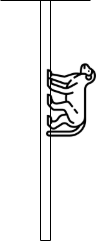
A uniform rope of mass m hangs freely from a ceiling. A monkey of mass M climbs up the rope with an acceleration a. The force exerted by the rope on the ceiling is:

A) $Ma + mg$
B) $M(g + a) + mg$
C) $M(a + g)$
D) $\text{Dependent on the position of monkey on the rope.}$
Answer
220.5k+ views
Hint: Recall that whenever two objects or bodies are in contact with each other, they exert a force on each other. One such force is the force of tension. The force of tension is a force carried by a rope, string or cable that acts along the length of the medium.
Complete step by step solution:
Given that the mass of rope is \[ = m\]
And the mass of the monkey is $ = M$
Acceleration of the monkey climbing up the rope is $ = a$
Now the net force of tension that is exerted by the rope on the ceiling is the sum of two forces acting on the rope. When the monkey will climb the ceiling, it will also exert a force on the ceiling. Also the rope will exert a force on itself in order to balance when the monkey climbs.
So the net force is given as
$\Rightarrow {T_{net}} = {F_{rope}} + {F_{monkey}}$or
$\Rightarrow {T_{net}} = {T_1} + {T_2}$---(i)
The force of tension acting on an object is equal to the product of the mass of the object and the force of gravity or the acceleration forces acting on the object.
The force exerted by the rope is ${T_1} = mg$
The force exerted by the monkey on ceiling is $ \Rightarrow {T_2} - Mg = Ma$
Or $ \Rightarrow {T_2} = Mg + Ma$
$ \Rightarrow {T_2} = M(g + a)$
Substitute the value of ${T_1},{T_2}$in equation (i),
$ \Rightarrow {T_{net}} = mg + M(g + a)$
The force exerted by the rope on the ceiling is $mg + M(g + a)$.
Option B is the right answer.
Note: It is to be noted that the force of tension is also known as the pair of action and reaction forces acting at the end of the object taken. The force of tension is felt in both the directions of the rope, string or cable. It is a pulling force and not a pushing force as the rope can not push.
Complete step by step solution:
Given that the mass of rope is \[ = m\]
And the mass of the monkey is $ = M$
Acceleration of the monkey climbing up the rope is $ = a$
Now the net force of tension that is exerted by the rope on the ceiling is the sum of two forces acting on the rope. When the monkey will climb the ceiling, it will also exert a force on the ceiling. Also the rope will exert a force on itself in order to balance when the monkey climbs.
So the net force is given as
$\Rightarrow {T_{net}} = {F_{rope}} + {F_{monkey}}$or
$\Rightarrow {T_{net}} = {T_1} + {T_2}$---(i)
The force of tension acting on an object is equal to the product of the mass of the object and the force of gravity or the acceleration forces acting on the object.
The force exerted by the rope is ${T_1} = mg$
The force exerted by the monkey on ceiling is $ \Rightarrow {T_2} - Mg = Ma$
Or $ \Rightarrow {T_2} = Mg + Ma$
$ \Rightarrow {T_2} = M(g + a)$
Substitute the value of ${T_1},{T_2}$in equation (i),
$ \Rightarrow {T_{net}} = mg + M(g + a)$
The force exerted by the rope on the ceiling is $mg + M(g + a)$.
Option B is the right answer.
Note: It is to be noted that the force of tension is also known as the pair of action and reaction forces acting at the end of the object taken. The force of tension is felt in both the directions of the rope, string or cable. It is a pulling force and not a pushing force as the rope can not push.
Recently Updated Pages
Mass vs Weight: Key Differences Explained for Students

Electricity and Magnetism Explained: Key Concepts & Applications

JEE Energetics Important Concepts and Tips for Exam Preparation

JEE Isolation, Preparation and Properties of Non-metals Important Concepts and Tips for Exam Preparation

JEE Main 2021 July 25 Shift 1 Question Paper with Answer Key

JEE Main 2021 July 22 Shift 2 Question Paper with Answer Key

Trending doubts
JEE Main 2026: Application Form Open, Exam Dates, Syllabus, Eligibility & Question Papers

Understanding Uniform Acceleration in Physics

Derivation of Equation of Trajectory Explained for Students

Hybridisation in Chemistry – Concept, Types & Applications

Understanding the Angle of Deviation in a Prism

How to Convert a Galvanometer into an Ammeter or Voltmeter

Other Pages
Thermodynamics Class 11 Physics Chapter 11 CBSE Notes - 2025-26

JEE Advanced Marks vs Ranks 2025: Understanding Category-wise Qualifying Marks and Previous Year Cut-offs

Units And Measurements Class 11 Physics Chapter 1 CBSE Notes - 2025-26

NCERT Solutions For Class 11 Physics Chapter 8 Mechanical Properties Of Solids

Motion in a Straight Line Class 11 Physics Chapter 2 CBSE Notes - 2025-26

NCERT Solutions for Class 11 Physics Chapter 7 Gravitation 2025-26




